KIA QUORIS 2015 Owners Manual
Manufacturer: KIA, Model Year: 2015, Model line: QUORIS, Model: KIA QUORIS 2015Pages: 486, PDF Size: 35.55 MB
Page 411 of 486
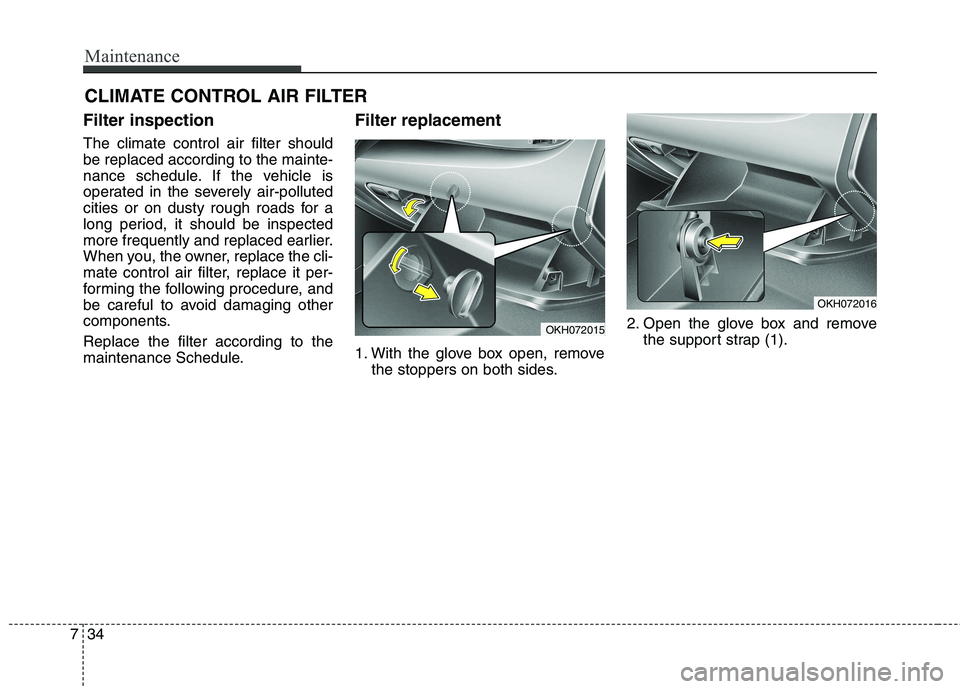
Maintenance
34
7
CLIMATE CONTROL AIR FILTER
Filter inspection The climate control air filter should be replaced according to the mainte-
nance schedule. If the vehicle is
operated in the severely air-polluted
cities or on dusty rough roads for a
long period, it should be inspected
more frequently and replaced earlier.
When you, the owner, replace the cli-
mate control air filter, replace it per-
forming the following procedure, and
be careful to avoid damaging other
components. Replace the filter according to the
maintenance Schedule. Filter replacement
1. With the glove box open, remove
the stoppers on both sides. 2. Open the glove box and remove
the support strap (1).
OKH072015
OKH072016
Page 412 of 486
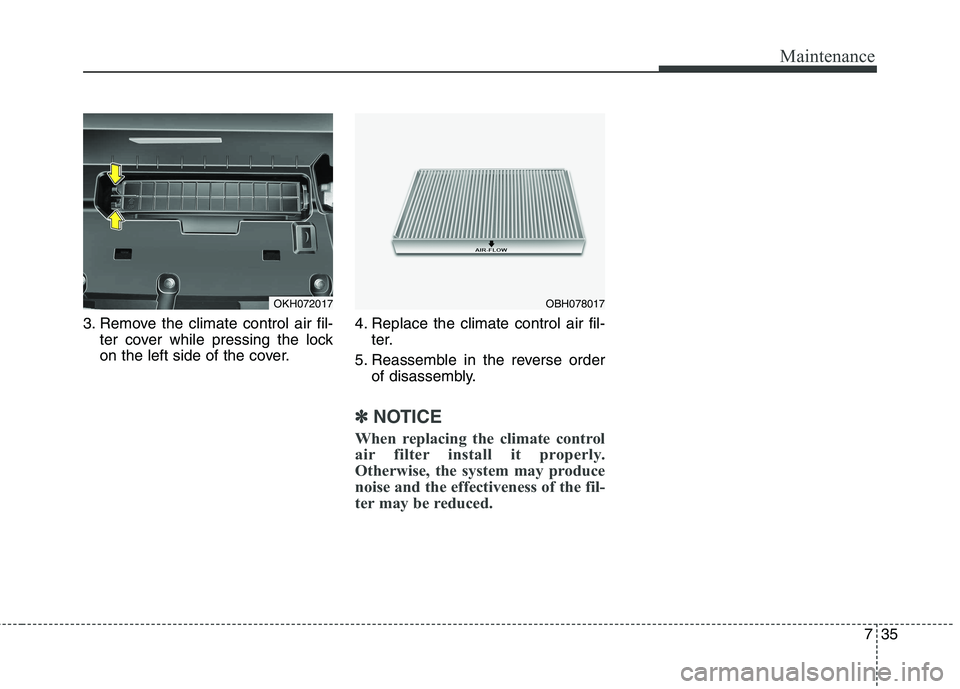
735
Maintenance
3. Remove the climate control air fil-ter cover while pressing the lock
on the left side of the cover. 4. Replace the climate control air fil-
ter.
5. Reassemble in the reverse order of disassembly.
✽✽ NOTICE
When replacing the climate control
air filter install it properly.
Otherwise, the system may produce
noise and the effectiveness of the fil-
ter may be reduced.
OKH072017OBH078017
Page 413 of 486
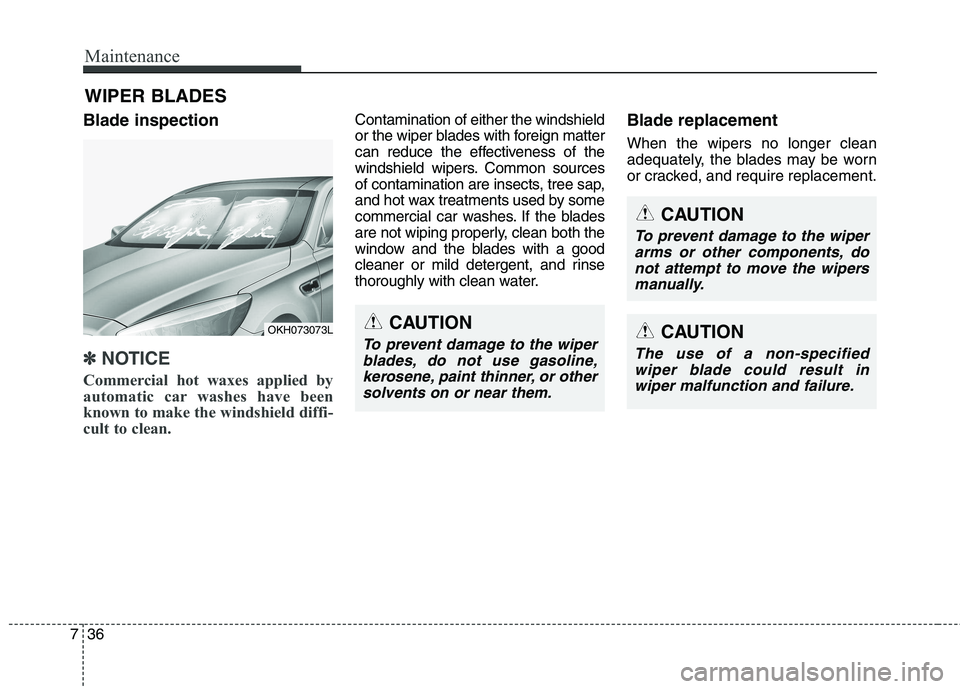
Maintenance
36
7
WIPER BLADES
Blade inspection
✽✽ NOTICE
Commercial hot waxes applied by
automatic car washes have been
known to make the windshield diffi-
cult to clean.
Contamination of either the windshield
or the wiper blades with foreign matter
can reduce the effectiveness of the
windshield wipers. Common sources
of contamination are insects, tree sap,
and hot wax treatments used by some
commercial car washes. If the blades
are not wiping properly, clean both the
window and the blades with a good
cleaner or mild detergent, and rinse
thoroughly with clean water. Blade replacement When the wipers no longer clean
adequately, the blades may be worn
or cracked, and require replacement.
OKH073073LCAUTION
To prevent damage to the wiper
blades, do not use gasoline,kerosene, paint thinner, or other solvents on or near them.
CAUTION
To prevent damage to the wiperarms or other components, donot attempt to move the wipers manually.
CAUTION
The use of a non-specifiedwiper blade could result inwiper malfunction and failure.
Page 414 of 486
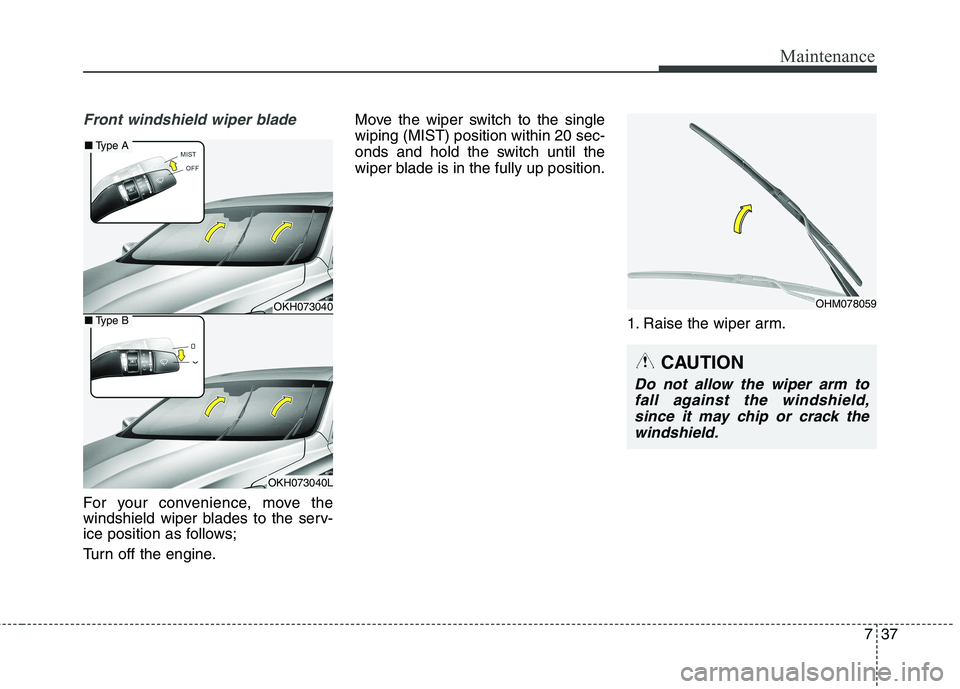
737
Maintenance
Front windshield wiper blade
For your convenience, move the
windshield wiper blades to the serv-
ice position as follows;
Turn off the engine.Move the wiper switch to the single wiping (MIST) position within 20 sec-
onds and hold the switch until the
wiper blade is in the fully up position.
1. Raise the wiper arm.
OHM078059
CAUTION
Do not allow the wiper arm tofall against the windshield,since it may chip or crack the windshield.
OKH073040
OKH073040L
■ Type A
■Type B
Page 415 of 486
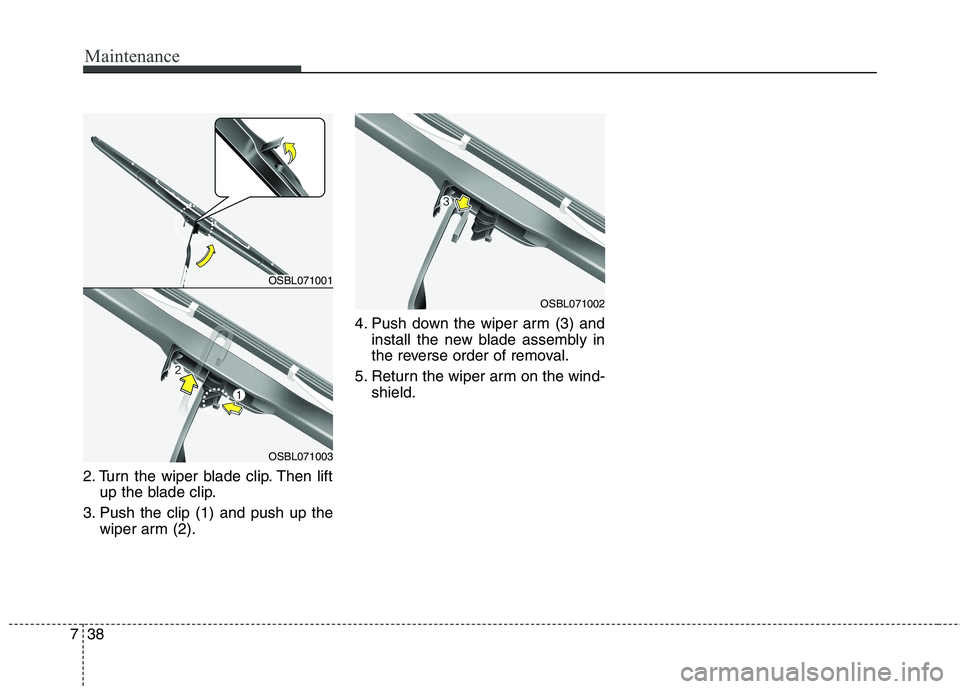
Maintenance
38
7
2. Turn the wiper blade clip. Then lift
up the blade clip.
3. Push the clip (1) and push up the wiper arm (2). 4. Push down the wiper arm (3) and
install the new blade assembly in
the reverse order of removal.
5. Return the wiper arm on the wind- shield.
OSBL071002
OSBL071001
OSBL071003
Page 416 of 486
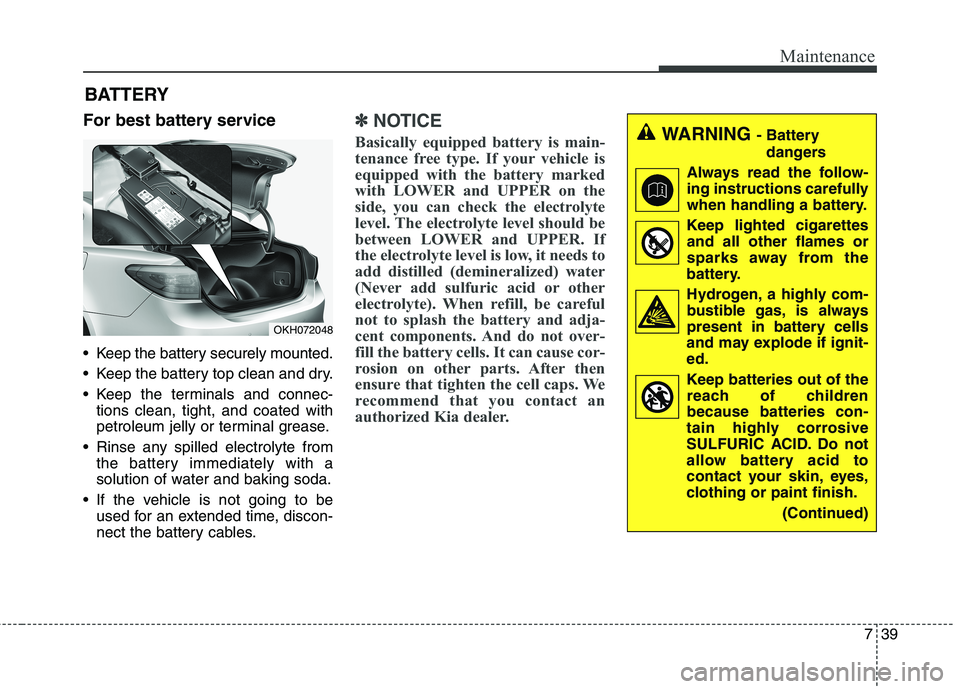
739
Maintenance
For best battery service
Keep the battery securely mounted.
Keep the battery top clean and dry.
Keep the terminals and connec-tions clean, tight, and coated with
petroleum jelly or terminal grease.
Rinse any spilled electrolyte from the battery immediately with a
solution of water and baking soda.
If the vehicle is not going to be used for an extended time, discon-
nect the battery cables.✽✽ NOTICE
Basically equipped battery is main-
tenance free type. If your vehicle is
equipped with the battery marked
with LOWER and UPPER on the
side, you can check the electrolyte
level. The electrolyte level should be
between LOWER and UPPER. If
the electrolyte level is low, it needs to
add distilled (demineralized) water
(Never add sulfuric acid or other
electrolyte). When refill, be careful
not to splash the battery and adja-
cent components. And do not over-
fill the battery cells. It can cause cor-
rosion on other parts. After then
ensure that tighten the cell caps. We
recommend that you contact an
authorized Kia dealer.
BATTERY
WARNING - Battery
dangers
Always read the follow-
ing instructions carefully
when handling a battery.
Keep lighted cigarettes and all other flames or
sparks away from the
battery.
Hydrogen, a highly com- bustible gas, is always
present in battery cells
and may explode if ignit-ed.
Keep batteries out of the reach of children because batteries con-
tain highly corrosive
SULFURIC ACID. Do not
allow battery acid to
contact your skin, eyes,
clothing or paint finish.
(Continued)
OKH072048
Page 417 of 486
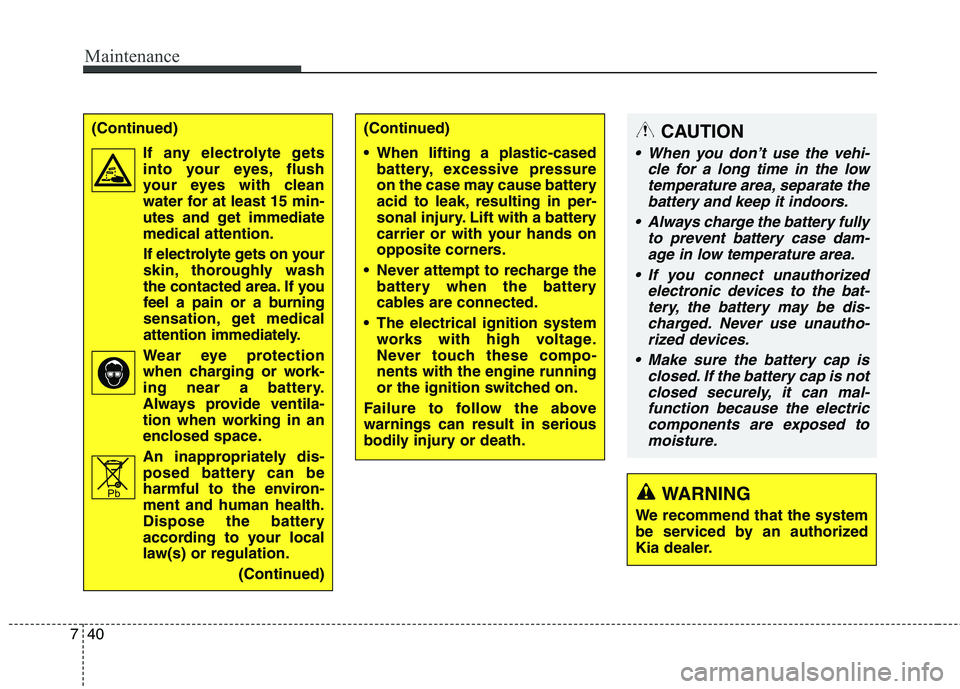
Maintenance
40
7
CAUTION
When you don’t use the vehi-
cle for a long time in the lowtemperature area, separate the battery and keep it indoors.
Always charge the battery fully to prevent battery case dam-age in low temperature area.
If you connect unauthorized electronic devices to the bat-tery, the battery may be dis- charged. Never use unautho-rized devices.
Make sure the battery cap is closed. If the battery cap is notclosed securely, it can mal- function because the electriccomponents are exposed tomoisture.
WARNING
We recommend that the system
be serviced by an authorized
Kia dealer.
(Continued)
When lifting a plastic-cased battery, excessive pressure
on the case may cause battery
acid to leak, resulting in per-
sonal injury. Lift with a battery
carrier or with your hands on
opposite corners.
Never attempt to recharge the battery when the battery
cables are connected.
The electrical ignition system works with high voltage.
Never touch these compo-nents with the engine running
or the ignition switched on.
Failure to follow the abovewarnings can result in serious
bodily injury or death.(Continued)
If any electrolyte getsinto your eyes, flush
your eyes with clean
water for at least 15 min-
utes and get immediatemedical attention.
If electrolyte gets on your
skin, thoroughly wash
the contacted area. If you
feel a pain or a burning
sensation, get medical
attention immediately.
Wear eye protection when charging or work-
ing near a battery.
Always provide ventila-
tion when working in an
enclosed space.
An inappropriately dis- posed battery can be
harmful to the environ-ment and human health.
Dispose the battery
according to your local
law(s) or regulation.
(Continued)
Pb
Page 418 of 486
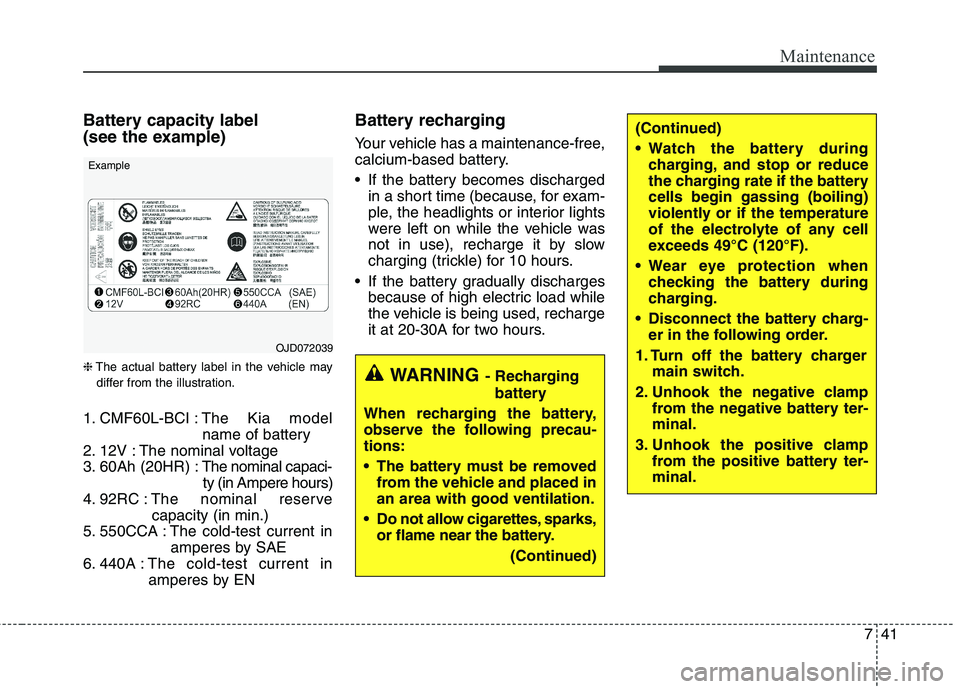
741
Maintenance
Battery capacity label
(see the example) ❈The actual battery label in the vehicle may
differ from the illustration.
1. CMF60L-BCI : The Kia model
name of battery
2. 12V : The nominal voltage
3. 60Ah (20HR) : The nominal capaci-
ty (in Ampere hours)
4. 92RC : The nominal reserve
capacity (in min.)
5. 550CCA : The cold-test current in amperes by SAE
6. 440A : The cold-test current in
amperes by EN Battery recharging
Your vehicle has a maintenance-free,
calcium-based battery.
If the battery becomes discharged
in a short time (because, for exam-
ple, the headlights or interior lights
were left on while the vehicle was
not in use), recharge it by slow
charging (trickle) for 10 hours.
If the battery gradually discharges because of high electric load while
the vehicle is being used, recharge
it at 20-30A for two hours.(Continued)
Watch the battery during charging, and stop or reduce
the charging rate if the batterycells begin gassing (boiling)
violently or if the temperature
of the electrolyte of any cell
exceeds 49°C (120°F).
Wear eye protection when checking the battery during
charging.
Disconnect the battery charg- er in the following order.
1. Turn off the battery charger main switch.
2. Unhook the negative clamp from the negative battery ter-minal.
3. Unhook the positive clamp from the positive battery ter-minal.
WARNING - Recharging
battery
When recharging the battery,
observe the following precau-tions:
The battery must be removed from the vehicle and placed in an area with good ventilation.
Do not allow cigarettes, sparks, or flame near the battery.
(Continued)
OJD072039
Example
Page 419 of 486

Maintenance
42
7
Reset items Items should be reset after the bat-
tery has been discharged or the bat-
tery has been disconnected.
Auto up/down window
(See section 4)
Sunroof (See section 4)
Driver position memory system (See section 4)
Trip computer (See section 4)
Climate control system (See section 4)
Clock (See section 4)
Audio (See section 4)WARNING
Before performing mainte- nance or recharging the bat-
tery, turn off all accessories
and stop the engine.
The negative battery cable must be removed first and
installed last when the batteryis disconnected.
We recommend that the sys- tem be serviced by an author-
ized Kia dealer.
CAUTION
Keep the battery away from
water or any liquid.
We recommend that you use parts for replacement from anauthorized Kia dealer.
Page 420 of 486
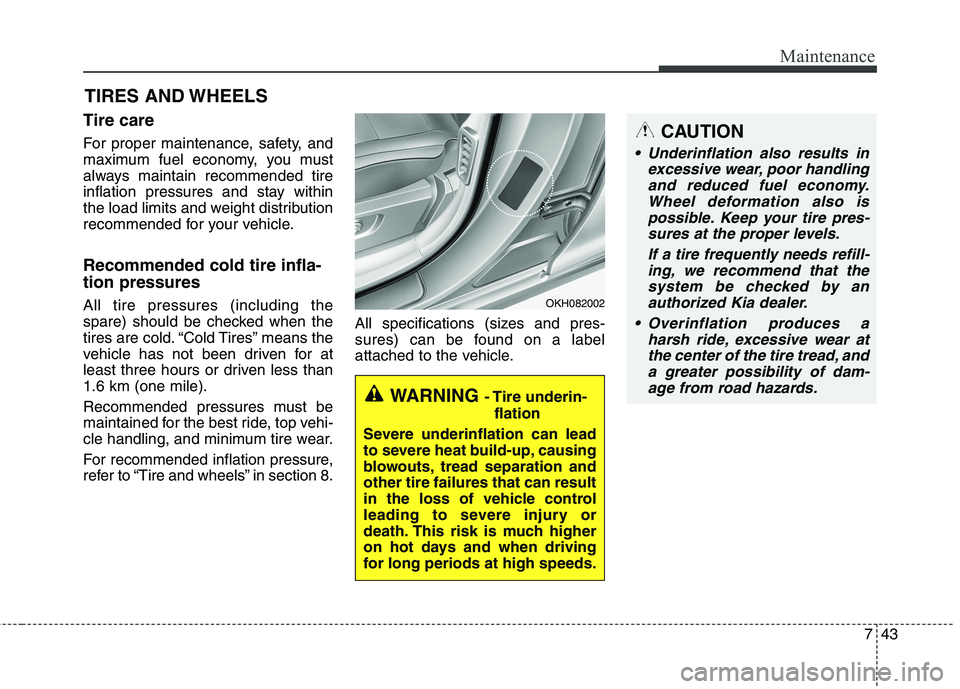
743
Maintenance
TIRES AND WHEELS
Tire care
For proper maintenance, safety, and
maximum fuel economy, you must
always maintain recommended tire
inflation pressures and stay within
the load limits and weight distribution
recommended for your vehicle. Recommended cold tire infla- tion pressures All tire pressures (including the
spare) should be checked when the
tires are cold. “Cold Tires” means the
vehicle has not been driven for at
least three hours or driven less than1.6 km (one mile).
Recommended pressures must be
maintained for the best ride, top vehi-
cle handling, and minimum tire wear.
For recommended inflation pressure,
refer to “Tire and wheels” in section 8. All specifications (sizes and pres-
sures) can be found on a label
attached to the vehicle.
WARNING
- Tire underin-
flation
Severe underinflation can lead
to severe heat build-up, causing
blowouts, tread separation andother tire failures that can result
in the loss of vehicle control
leading to severe injury or
death. This risk is much higher
on hot days and when driving
for long periods at high speeds.
OKH082002
CAUTION
Underinflation also results in excessive wear, poor handlingand reduced fuel economy. Wheel deformation also ispossible. Keep your tire pres-sures at the proper levels.
If a tire frequently needs refill-ing, we recommend that thesystem be checked by anauthorized Kia dealer.
Overinflation produces a harsh ride, excessive wear atthe center of the tire tread, anda greater possibility of dam-age from road hazards.